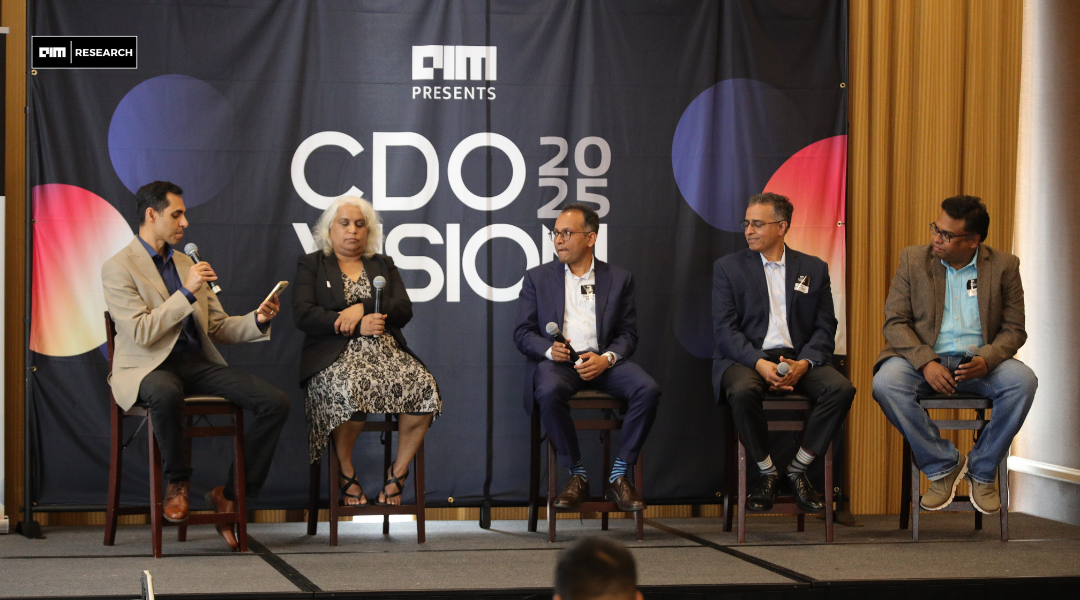
AI In Customer Experience: Insights From CDO Vision Dallas
- By Upasana Banerjee
- Published on
Organizations must approach AI implementation with realistic expectations and robust governance


The AI era has fundamentally changed how we think about customers. Today’s organizations serve two distinct types: organic customers (humans) and inorganic customers (AI systems that exhibit human-like behaviors). This distinction matters because each requires different interaction approaches and service experiences.
This panel brings together a diverse group of financial services and AI experts. Poornakala Sethuraman serves as VP Data Scientist at Bank of America, bringing banking sector expertise in data science applications. Karthik Balakrishnan contributes 25+ years of AI experience in financial services, with particular depth in the insurance industry. Awhan Mohanty leads growth initiatives for banking and financial services at Quantity, offering perspectives on business development and market expansion. Anshuman Bhar rounds out the panel as founder and CEO of Aays, providing entrepreneurial insights on building AI-focused companies. Together, they represent a comprehensive view spanning technical implementation, industry experience, business strategy, and startup leadership in the financial AI space.
Insurance Technology
AI transforms the entire insurance value chain. In trucking insurance, companies use generative AI to automatically extract critical information from agent submissions, truck details, VIN numbers, driver information, eliminating manual data entry and reducing quote generation time.
On the risk assessment side, AI powers actuarial analysis to price policies appropriately. Post-sale, AI chatbots handle routine customer inquiries, analyzing emails to determine if they can respond within their authorized domain before addressing customer requests.
Financial Services
Banking and payment processing present unique AI challenges. Each domain requires specialized solutions rather than plug-and-play approaches. A bank’s address change request system differs fundamentally from a payment processor’s distress call handling, where conversations can last 40-50 minutes due to urgent financial situations.
The key lies in standardizing backend infrastructure while customizing front-end experiences. Intent recognition mechanisms must adapt to industry-specific contexts while maintaining compliance requirements and empathetic responses.
Organizations face a critical tension between immediate returns and sustainable competitive advantage. Financial services companies have discovered this isn’t an either-or decision. Well-built AI solutions create reusable assets that serve both purposes.
AI’s rapid evolution means today’s quick wins become tomorrow’s commodities. Solutions that once required significant effort like model fine-tuning are becoming standard features. The strategic advantage window for any AI capability is shrinking rapidly.
The winning approach focuses on domain-specific, difficult-to-replicate solutions. A supply chain company should break complex logistics problems into smaller components, creating sophisticated workflows tailored to their unique business needs. This approach builds reusable capabilities while addressing immediate needs.
However, sustainable competitive advantage in AI isn’t about defending technological moats, it’s about people, processes, and organizational mindset. Companies must innovate continuously, as today’s breakthrough becomes tomorrow’s table stakes.
AI represents a new operating system requiring fundamental mindset shifts. This extends beyond technical teams to business users who must learn to work alongside AI systems effectively. The challenge involves:
The focus should be on training both internal teams and external customers, leveraging the abundant free resources now available from major technology providers.
Regulated industries face heightened scrutiny around AI implementation. Insurance regulators now examine not just model outputs but the entire data pipeline—collection methods, usage rights, synthesis techniques, and bias detection. This regulatory focus is expanding upstream, making proactive ethical policies essential.
Customer sentiment also drives ethical considerations. Organizations with strong data privacy and ethical AI policies gain competitive advantages in markets where consumers are increasingly educated about these issues.

1. Fairness Models must behave consistently across different customer segments and use cases. Financial services applications require particularly careful evaluation, as fairness parameters vary significantly between consumer banking, capital markets, and wealth management.
2. Transparency Organizations need clear explanations for AI outputs—the what, why, and how of every decision. This transparency becomes critical when dealing with high-stakes customer interactions or regulatory compliance.
3. Data Privacy All AI solutions must pass rigorous data privacy checklists aligned with industry-specific regulations. This requirement spans decades of established privacy practices but requires new applications in AI contexts.
4. Human in the Loop Current AI models excel at style but struggle with factual accuracy. They can simulate thinking without actually reasoning. This limitation necessitates human oversight, particularly in customer-facing applications where misinformation carries serious consequences.
The gap between AI capabilities and human expectations creates unique challenges. While AI can draft regulatory reports like Suspicious Activity Reports (SARs) for banks, the downside risk of incorrect submissions far exceeds automation benefits. Human reviewers must verify all outputs before submission.
Additionally, humans naturally prefer personal interaction over mechanical responses, especially in high-stakes situations. This psychological preference requires careful balance between efficiency gains and customer satisfaction.
Organizations must approach AI implementation with realistic expectations and robust governance. The technology’s rapid evolution demands continuous adaptation while maintaining ethical standards and regulatory compliance.
Success requires viewing AI as an operating system rather than a simple tool, investing in comprehensive training programs, and building sustainable competitive advantages through domain-specific expertise rather than generic AI capabilities.
The future belongs to organizations that can balance AI’s efficiency gains with human judgment, creating customer experiences that are both technologically advanced and fundamentally human-centered.
📣 Want to advertise in AIM Research? Book here >

Cypher 2024
21-22 Nov 2024, Santa Clara Convention Center, CA
A Vendor Briefing is a research tool for our industry analysts, and an opportunity for a vendor to present its products, services and business strategies to analysts who cover the vendor specifically or a related technology or market.
AIM Research encourages technology vendors and agencies to brief our team for PeMa Quadrants, when introducing a new product, changing a business model, or forming a partnership, merger, or acquisition.


